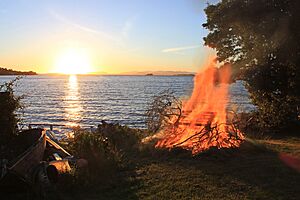June facts for kids
June is the sixth month of the year. It follows May and comes before July. June has 30 days. It is part of both the Julian calendar and the Gregorian calendar, which is the most used calendar today.
In the Northern Hemisphere, June marks the start of summer. It includes the summer solstice, which is the day with the most daylight hours. In the Southern Hemisphere, June is the start of winter. It has the winter solstice, which is the day with the fewest hours of daylight.
The Atlantic hurricane season begins on June 1st. This is when tropical storms are most likely to form in the North Atlantic Ocean. This season lasts until November 30th. The East Asian rainy season also usually starts in June. Several meteor showers happen in June. One is the Arietids, which are very bright daylight meteor showers. They occur from May 22nd to July 2nd, with the strongest display around June 8th.
Many special events and observances take place in June. Midsummer is a celebration of the summer solstice in the Northern Hemisphere. In Catholicism, June is known as the Month of the Sacred Heart, dedicated to the Sacred Heart of Jesus. In the United States, Pride Month is a well-known observance in June. It celebrates LGBT people and their fight for equal rights.

Contents
What is June?
June is the sixth month of the year. It has 30 days. June comes after May and before July. It is one of four months that have 30 days. The others are April, September, and November. June is often shortened to Jun.
The name June comes from the Latin word Iunius. This word was named after the ancient Roman goddess Juno. The name June came into English in the 1200s.
How June's Calendar Came to Be
June comes from the Roman month Iunius. This was part of the original Roman calendar. At first, Iunius was the fourth month and had 29 days. It is not clear when the Romans changed their calendar. They later moved January and February to the beginning of the year. This made Iunius the sixth month.
In 46 BC, Julius Caesar changed the calendar. This new calendar was called the Julian calendar. It set the year to 365 days. It also added a leap year every four years. This change made June 30 days long. However, the Julian calendar was a little bit longer than the Earth's actual trip around the Sun.
So, in 1582, Pope Gregory XIII created a new calendar. This was the Gregorian calendar. It made the average year length more accurate. This corrected the small difference in the Julian calendar.
Weather, Daylight, and Space in June
In the Northern Hemisphere, June marks the start of summer. In the Southern Hemisphere, it is the start of winter. The official start of summer in the Northern Hemisphere is June 21st. The official start of winter in the Southern Hemisphere is also June 21st.
The June solstice happens between June 20th and 22nd, often on June 21st. This day is called the summer solstice in the Northern Hemisphere. It is the longest day of the year with the most daylight. In the Southern Hemisphere, it is the winter solstice. This is the shortest day of the year. In places far north or south, like the Arctic Circle, the midnight sun can be seen. This means the Sun stays visible even at midnight.
The Atlantic hurricane season starts on June 1st. This is when tropical storms are most likely to form. This season lasts until November 30th. In the Indian Ocean, tropical storms are common in May and June. The East Asian rainy season usually begins in June.
Several meteor showers happen in June:
- The Arietids are bright daylight meteor showers. They occur from May 22nd to July 2nd. They are strongest around June 8th.
- The Beta Taurids happen from June 5th to July 18th. They peak around June 28th.
- The June Bootids occur from June 22nd to July 2nd. They are strongest around June 27th.
Special Events and Celebrations in June
In Catholicism, June is a special month. It is dedicated to the Sacred Heart of Jesus. This is called the Month of the Sacred Heart.
In Canada, June is ALS Awareness Month. This campaign helps people learn about and raise money for amyotrophic lateral sclerosis. It is also Filipino Heritage Month. In the United States, June is National Safety Month. This month aims to make people more aware of safety risks. The goal is to reduce injuries and deaths.
June is also Pride Month in the United States. This month celebrates LGBT individuals. It also highlights their efforts to gain equal rights. Caribbean-American Heritage Month also happens in June. In the United Kingdom, National Smile Month promotes good oral health. In Barbados, June is part of the Season of Emancipation. This period remembers the freedom of enslaved people of African descent.
Global Celebrations in June
Many important international holidays are celebrated in June:
- Fixed Dates
- 1 June: International Children's Day and World Milk Day
- 4 June: Tiananmen Square protests anniversary
- 15 June: Global Wind Day
- 16 June: International Day of the African Child
- 18 June: Autistic Pride Day
- 19 June: World Sauntering Day
- 21 June: Go Skateboarding Day; Midsummer; World Hydrography Day; World Music Day
- 25 June: World Vitiligo Day
- 26 June: World Refrigeration Day
- Dates That Change
- First Wednesday: Global Running Day
- Third Saturday: International Surfing Day
- Third Sunday: Father's Day
- Varies: King's Official Birthday
United Nations Observances
The United Nations formally observes these global holidays:
- 1 June: Global Day of Parents
- 3 June: World Bicycle Day
- 4 June: International Day of Innocent Children Victims of Aggression
- 5 June: World Environment Day and International Day for the Fight Against Illegal, Unreported and Unregulated Fishing
- 6 June: D-Day
- 7 June: World Food Safety Day
- 8 June: World Oceans Day
- 12 June: World Day Against Child Labour
- 13 June: International Albinism Awareness Day
- 14 June: World Blood Donor Day
- 15 June: World Elder Abuse Awareness Day
- 16 June: International Day of Family Remittances
- 17 June: World Day to Combat Desertification and Drought
- 18 June: International Day for Countering Hate Speech and Sustainable Gastronomy Day
- 19 June: International Day for the Elimination of ... Violence in Conflict
- 20 June: World Refugee Day
- 21 June: International Day of Yoga
- 23 June: United Nations Public Service Day and International Widows' Day
- 24 June: International Day of Women in Diplomacy
- 25 June: Day of the Seafarer
- 26 June: International Day Against Drug Abuse and Illicit Trafficking and International Day in Support of Victims of Torture
- 27 June: Micro-, Small and Medium-sized Enterprises Day
- 29 June: International Day of the Tropics
- 30 June: International Asteroid Day and International Day of Parliamentarism
Religious Holidays in June
Some religious holidays can fall in June. Ascension Day is 39 days after Easter. Pentecost is 50 days after Easter Sunday. Trinity Sunday is the first Sunday after Pentecost. The Catholic Church celebrates the Feast of the Sacred Heart on the Friday after the second Sunday after Pentecost. The Feast of Corpus Christi is celebrated by some churches on the Thursday after Trinity Sunday. The feast of Saints Peter and Paul is always on June 29th.
In Buddhism, Vesak (Buddha Day) is a very important festival. In 2024, it was on June 2nd in Singapore and June 3rd in Thailand. Shavuot is a Jewish holiday. It takes place during the Hebrew month of Sivan, which is usually in May or June.
Symbols of June
For people born between May 21st and June 21st, their Zodiac sign is Gemini. For those born between June 22nd and July 22nd, their sign is Cancer.
The birthstones for June are pearl, moonstone, and alexandrite. The birth flowers of June are the rose and the honeysuckle.
See also
 In Spanish: Junio para niños
In Spanish: Junio para niños


